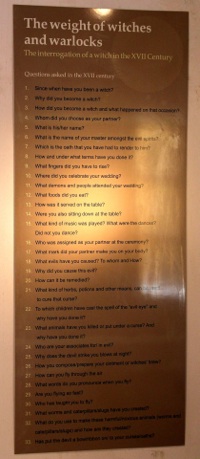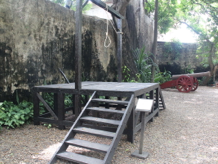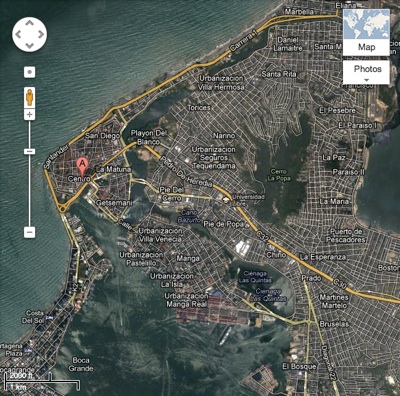Northern South America Travel Diary
2012

Northern South America Travel Diary 2012
Colombia Ecuador Guyana Panama Suriname Trinidad
My first thought when I woke this morning was “I need to look outside and check the weather”. When I did so, my second thought was “Great! The forecasters got it wrong!”. The view from my hotel room was of a beautiful, sunlit beach landscape with crystal clear blue skies, with not a cloud in sight.
That was at 7:30 am. By the time I had breakfast and had caught a taxi to the old city, it was 9:15 am, and the clouds were already starting to form white masses overhead.
Yesterday afternoon, as I was walking just outside the walls of the old town, I discovered by accident that Cartagena has recently introduced one of those red double decker open top sightseeing buses. I had used these open-top buses in Havana and Washington DC earlier this year, and I was very impressed with them as a way of getting an overview of a city, so I decided to try the one here in Cartagena.
I checked the times online, and saw that the buses were not very frequent (I think they have a grand total of one in the fleet here). The first bus was due to leave the Muelle de los Pegasos (Cartagena’s old port with fishing boats and a couple of old galleons) at 9:51 am. I arrived at 9:30 am, to be told by a man who spoke no English (yes, communication still works without a common language!) that the schedule had changed and the bus was now due at 10:30 am. As things turned out, I needed all of that extra hour for the condensation inside the lens of my camera to clear. I experienced the same problem this morning that I had in Paramaribo, which was that the air was so hot and humid that condensation formed around the internal elements of my camera lens. There was no way to take apart the lens; I just had to wait, and wait, and wait.
I did so by sitting on a bench near the main gate into the old town, Puerta del Reloj. The plaza where I sat (Plaza de los Cloches) was once the slave market; this morning it was much calmer, and yet I was approached by four people while I was sitting there – one wanted to sell me a T-shirt, one wanted to sell me some water, and finally a lovely young couple wanted to convert me into a Jehovah’s Witness.
Finally, the condensation on my lens cleared, by which time the clouds were starting to thicken overhead (surely the condensation from my lens couldn’t be increasing the atmospheric humidity by THAT much!). I returned to the bus stop, and had a great conversation with a Brazilian man and his wife while waiting for the bus, and we waited, and we waited…
The bus finally arrived, about 20 minutes late. We boarded, but the driver seemed to be in no hurry to get underway. We finally departed, but because we were now running so late, the driver decided to take a short cut and delete part of the circuit. Having done so, we arrived at our first stop (Castillo de San Felipe, or St Phillip’s Castle) about 10 minutes early. We therefore sat there, with the engine idling, not for the 10 minutes that we were early, but almost 20. Even when we started moving, the driver seemed in no hurry; we spent most of the trip in first gear, although he may have switched to second at one point on the highway. It was good for photos, but very, very slow.
On several occasions on the circuit, we stopped for 5 or 10 minutes at a stop for no apparent reason (although I did notice that the driver went into McDonalds and came out looking well fed and satisfied with the remains of a meal at one of our stops).
It was not my best experience with open-top double decker buses, but it did give me some insight into greater Cartagena away from the old town. Furthermore, the circuit confirmed my earlier wisdom of focussing mainly on the old town – most of the other areas we drove through had large-scale beach resort development which, while interesting in its own way, was not my main priority.
The price of the ticket included a 45 minute walking tour through the old town. Theoretically a guide meets each bus when it arrives at a certain stop, but there was no-one to meet our bus when it arrived. That didn’t really worry me as we had been given a map of the walking route, and the commentary was to be in Spanish only. Moreover, I usually prefer to take things at my own pace to get photographs, wandering down side alleys as the fancy takes me, and so on.
Before I began the walking tour, however, I backtracked a little to a place beside the sea where I had seen some fishermen (or, to be more politically correct, fisherfolk, or fishers, all of whom were men) repairing their boats and gutting some fish. They seemed genuinely delighted when I arrived with my camera, even to the point of throwing small pieces of fish to attract some sea birds for my photos. After lots of smiling and waving, I returned to the small archway in the city wall that served as an entrance to the old town, and I began walking tour following the map I had been given in the bus.
The walk was wonderful. The route suggested on the map covered almost all of that part of the old town where I had not explored yesterday afternoon. As a result, although I would not claim to have walked every street in Cartagena’s old town, I don’t think there are too many streets that I have missed.
The more I walked, the more impressed I was with Cartagena. It is a world away from Colombia’s capital city, Bogotá. Cartagena is elegant, safe, relaxed, historical, colourful, pretty – in sort, a fabulous place to wander around and soak up some history, and then relax with some good swimming or a little sleep afterwards.
As was the case yesterday afternoon, the highlight of my walk was the city streetscape in general rather than any one sight. It is probably fair to say that the old buildings in the area where I walked today (more towards the northern side of the old town) had been restored more completely than those in some of the areas where I was wandering yesterday afternoon.
Nonetheless, a few places are worthy of mention. In the city walls at the north-eastern end of the old town, a row of 23 tourist shops were found, each identically sized and styled with an arched frontage. Apparently in the colonial times of the 18th century, these were built as the city’s dungeons.
The museum had a vast array of the tools of torture that were used during the Inquisition (all originals of course, no replicas). Especially fascinating was the list of questions used to interrogate witches and warlocks in the 17th century (see image here, to the left - click to enlarge). And if the tools of torture (rack, thumbscrews, hand saw, head crusher, and many more) weren’t enough, there were the dungeons, and a skull or two to admire, not to mention the stock and hangman’s noose in the very quiet, shady, picturesque courtyard outside.
All the inquisition exhibits were on the ground floor of the building. On an upper level there was also an exhibition of the history of Cartagena, but it really paled in comparison with the main exhibition.
Having perhaps spent more time than I should in the Palacio de la Inquisición, I headed south to a corner of the old town that I had not seen yesterday. This area included Cartagena’s oldest and largest plaza, the Plaza de la Aduana, which used to be used during colonial times as a parade ground, surrounded by government buildings. Nearby was the huge Iglesia de San Pedro Claver, named after the Jesuit Saint Peter Claver, whose body apparently resides in a glass coffin in the high altar. Having worked in two Jesuit schools for over a decade back in the 1970s and 1980s, I was interested in having a look inside the church and its accompanying museum, but unfortunately my dwindling supply of Colombian pesos could not quite accommodate the entry fee (unless I were to have forsaken a taxi ride and walked the nine kilometres back to my hotel), so I had to satisfy myself with admiring the exterior and the surrounding courtyard.
By this time, I had been exploring Cartagena for about seven hours, and fatigue (not to mention thirst) was starting to set in. I therefore decided it was time to head back to the hotel. The timing was good, as just a few minutes after my return the skies darkened suddenly and the thunderstorm that had been forecast finally hit, and it did so with a vengeance. The rainfall was torrential, the lightning and thunder were intense, and the hotel lost power for a while. Although the storm lasted only a little more than half an hour or so, a quick check of the beach near my hotel showed that there had been quite a bit of erosion during the storm – not from wave action, but as a result of the rising water table destabilising the sand on the beach, leading to some significant gullying near the wave-sediment interface.
It was quite a dramatic conclusion to a great day’s explorations.

Day 14 - Cartagena, Colombia
Saturday
7 July 2012
Today’s extra bonus images






































